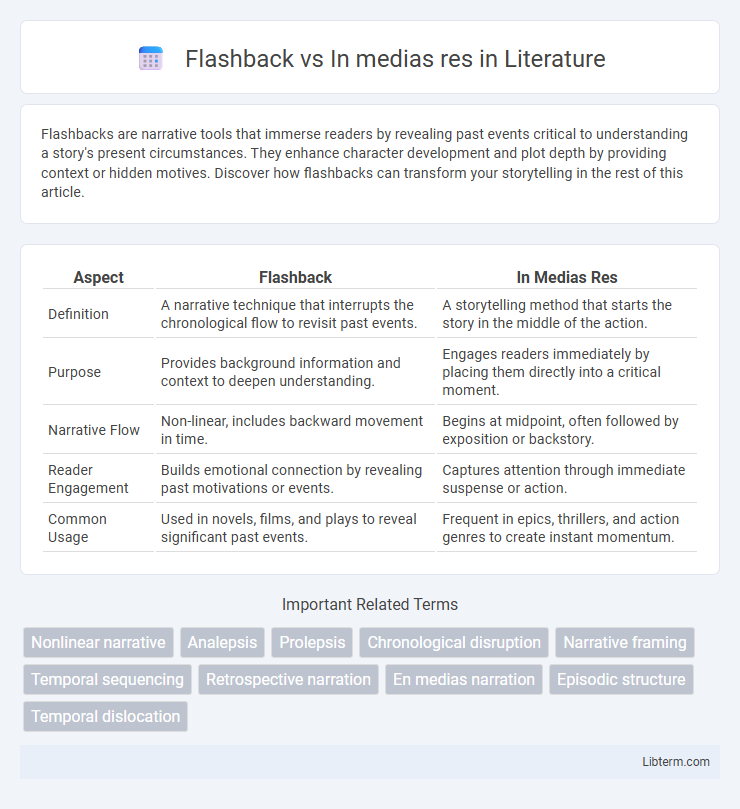Flashbacks are narrative tools that immerse readers by revealing past events critical to understanding a story's present circumstances. They enhance character development and plot depth by providing context or hidden motives. Discover how flashbacks can transform your storytelling in the rest of this article.
Table of Comparison
| Aspect | Flashback | In Medias Res |
|---|---|---|
| Definition | A narrative technique that interrupts the chronological flow to revisit past events. | A storytelling method that starts the story in the middle of the action. |
| Purpose | Provides background information and context to deepen understanding. | Engages readers immediately by placing them directly into a critical moment. |
| Narrative Flow | Non-linear, includes backward movement in time. | Begins at midpoint, often followed by exposition or backstory. |
| Reader Engagement | Builds emotional connection by revealing past motivations or events. | Captures attention through immediate suspense or action. |
| Common Usage | Used in novels, films, and plays to reveal significant past events. | Frequent in epics, thrillers, and action genres to create instant momentum. |
Understanding Flashback and In Medias Res
Flashback is a narrative technique that interrupts the chronological flow of a story to revisit past events, providing essential background or context that influences the present narrative. In medias res begins a story in the middle of the action, immediately engaging the audience by dropping them into a crucial moment, with earlier events revealed gradually through exposition or flashbacks. Both techniques enhance storytelling by manipulating time, where flashbacks clarify motivations and in medias res creates suspense and urgency.
Defining Flashback: A Narrative Device
Flashback is a narrative device that interrupts the chronological sequence of events to depict moments from the past, providing critical background or context to the current storyline. It enables deeper character development and enhances plot complexity by revealing motivations or prior incidents that influence present actions. Unlike in medias res, which starts a story amid action, flashbacks serve as deliberate retrospections embedded within the main narrative flow.
In Medias Res: Starting the Story Midstream
In medias res begins the narrative in the middle of the action, immersing readers immediately in a pivotal moment or conflict, which creates instant engagement and suspense. This technique contrasts with flashback, which interrupts the chronological flow to reveal past events for context or character motivation. By starting midstream, in medias res encourages audiences to piece together the backstory gradually, fostering active interpretation and heightened curiosity.
Key Differences Between Flashback and In Medias Res
Flashback narrates past events to provide context or background, while in medias res begins the story in the middle of the action. Flashback disrupts chronological order to fill in gaps, whereas in medias res immerses the audience immediately in a pivotal moment. Flashbacks serve as explanatory devices, and in medias res rely on unfolding the story through present events and later revelations.
Advantages of Using Flashback
Flashback techniques allow writers to provide essential background information that enriches character development and plot context without disrupting the narrative flow. This method enhances emotional engagement by revealing past events that explain characters' motivations and conflicts, creating a deeper connection with the audience. Employing flashbacks also enables non-linear storytelling, which can increase suspense and maintain reader interest by gradually unveiling critical plot points.
Benefits of In Medias Res in Storytelling
In medias res enhances storytelling by immediately engaging the audience through action or conflict, creating a sense of urgency and intrigue. This technique allows writers to reveal character motivation and plot development more dynamically, fostering emotional investment. By starting in the middle of the story, it avoids lengthy exposition and maintains narrative momentum, making the story more compelling and immersive.
When to Use Flashback vs In Medias Res
Use flashbacks to provide critical background information or reveal a character's motivations that enhance the understanding of the present narrative. In medias res is effective for grabbing immediate reader attention by starting the story in the middle of action, building suspense and encouraging engagement through unfolding context. Choose flashbacks when past events shape the current plot and in medias res when pacing and momentum are essential to drive the story forward.
Examples of Flashback in Literature and Film
Flashback is a narrative technique that interrupts chronological storytelling to depict past events, enriching character development and plot context, as seen in F. Scott Fitzgerald's "The Great Gatsby," where Gatsby's memories reveal his motivations. In film, "The Godfather Part II" employs flashbacks to explore Vito Corleone's early life, providing depth to his character and the Mafia's origins. Contrastingly, in medias res starts the story amid the action, with background details revealed later.
In Medias Res: Iconic Moments in Storytelling
In medias res begins a narrative in the midst of action, captivating the audience with iconic moments that reveal critical plot points and emotional intensity immediately. This storytelling technique immerses readers directly into high-stakes scenarios, enhancing engagement and suspense without the need for extensive background exposition. By contrast, flashbacks interrupt the linear flow to provide context, but in medias res harnesses momentum and intrigue from the outset to create a powerful, dynamic narrative experience.
Choosing the Right Device for Your Narrative
Choosing between flashback and in medias res depends on your narrative goals and pacing; flashbacks provide background context by revealing past events, enriching character development and motivations, while in medias res immerses readers directly in the action, generating immediate tension and engagement. Flashbacks work best when understanding past occurrences is crucial for plot clarity, whereas in medias res is ideal for stories aiming to captivate audiences quickly or maintain suspense. Balancing these narrative devices enhances storytelling by strategically managing information flow and emotional impact.
Flashback Infographic

 libterm.com
libterm.com